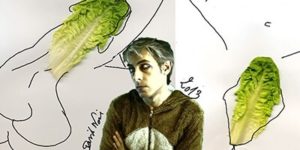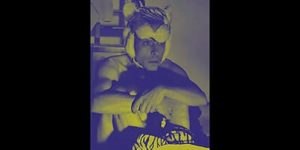Last night, came back late after the workshop | AMOK
As usual, need to relax before bed with a bite to eat in front of the TV. Brain flushing; refurbishment but not with anything. Zapping around looking for things to engage with. Cartoons, often at this hour. Incredibly inventive. But not now. In front of the scrolling of random images, suddenly caught up in the old-fashioned beauty and slow rhythm of a black and white film on channel 3. Reunion with an old feeling, the one accompanying the intriguing and sometimes troubled discoveries offered by the Midnight Cinema of my childhood. The context has changed a bit due to the myriad of surrounding channels, but if you take the trouble to immerse yourself in it, everything works again. I even thought I heard Patrick Brion's voice. It's not an auditory illusion; it's him. Since the distant days of my film studies and my galloping cinephilia at the time, I never imagined that the programme still existed; or perhaps I had realised it one day, out of the corner of my eye, at the bend of a Sunday evening like yesterday, but confusedly, distractedly.
The film is called "Amok". I catch it on the way. The scene is played out between Marcelle Chantal, the lead actress, an incredible mixture of languor and sophistication, a little something of Garbo in her eyes with silver shades in the light, and Jean Servais, a charming young sad actor, impeccable in his white colonial military suit. Both have the characteristic accent, tinged with melancholy, of the play of their time. I can't help but continue to watch them evolve, gradually understanding the drama that life confronts them with. She, pregnant with his child, lets him know half-heartedly, almost in jest. He reacts, suddenly downcast, concerned. She changes her mind, pretends it's a lie; nothing more will do. She will have an abortion of the fruit of her adultery. We are in Malaysia, with a colonial atmosphere and spirit. Her husband is returning by boat from a long absence. A doctor has been obsessed with her since, it seems, she came to him to ask him to perform the procedure, yet she is unwilling to look at him as anything other than a practitioner she despises from the height of her status as a humiliated rich aristocrat. I understand this as I go along and will check it out later on the Internet, having missed the beginning of the plot. He wants to be considered as something other than the interlocutor of a vulgar transaction; he wants her to address him humanely; he wants her to come down from her pedestal and beg him. She refuses, has an operation performed by a clandestine angel-maker in Chinatown and dies of haemorrhage. Beforehand, he immediately regrets his attitude and never stops trying to make amends. He pursues her even into the society parties she attends, faces her rejection, her looks of hatred and her pout of disgust, and ends up luring her into a brothel to confide in her, in despair, his dismay and the torture of his soul since their meeting. A surprising and magnificent moment, of unclassifiable beauty, when Fréhel appears on the balcony of the wretched brothel, singing the distraught expectation of the absent sailor. Finally, he will accompany her in death by rushing into the waves after her coffin, which is about to be taken away by the husband, who has just returned from a trip and discovers the drama. Before her eyes, the doctor hangs himself from the rope, breaks it with a knife, and falls to the bottom of the abyss with the body about to be repatriated to Europe, to spare her the shame of the autopsy. True to his painful promise, made under the seal of secrecy, to the woman to whom he swore that no one would know the true cause of her death, the doctor is dragged along, chained in this way until he reaches the "unthinkable", unforeseeable only a few days earlier. I say "the doctor" as I say "her", because what is extraordinary in this story is that each one has very little importance in the life of the other if you look closely. There is nothing that binds them together. It is not this couple, the lovers of the film, whose narrative vein any other story would have gladly exploited. This is the Amok; the curse, the madness, we don't know; which disrupts the normal course of things and seizes with violence those who have been humiliated. The more scientific articles on this subject speak of sudden decompensation. Normally, the term seems to refer to an individual homicidal mania, observed anywhere in the world, but finally theorised from cases observed in Malaysia. A homicidal delirium that can sometimes lead to suicide. Would it be fair to invoke Amok to talk about the bloody shootings that the United States has faced since Columbine and probably before? I don't know. But in my reading after watching the film in fascination, I do learn something. I am surprised and delighted at the same time to come across, behind this strange scenario, the path of an author familiar to me from my peregrinations mixing creation, culture and psyche, Stefan Zweig. Indeed, he is the author of the short story adapted under this same title, three times in the cinema, and all things considered, I am not that surprised. In the end, something is not very surprising in this origin, nor in the feeling that the film version leaves me with. Something that, already twenty years ago, crossed my path through the reading of The confusion of feelings and gave the impetus to the making of a video that was decisive for the continuation of my work, The loose animals.
There is a zone, the most exciting and powerful of all, where confusion and intuition, uncertainty and attraction, disbelief and persuasion merge into a dense and percussive object, perhaps suitable for the monolithic material of 2001: A Space Odyssey or the philosopher's stone as seen by Jung. It is a zone in the sense that Tarkovsky speaks of it in Stalker. This is "The" Zone, where it is essential to go, but from which one must return, escaping the grip of the Amok. It is there that light and night are combined. It is there that the stature of a possible greatness is revealed to man, which pushes him to continue to be, in order to reach one day perhaps, beyond himself.
Even if it is dangerous to understand it literally, the Amok is nevertheless a phenomenon that the self-seeking person must address. Through rejection and humiliation and not by going over it, a part of oneself is put to death that needed to be slaughtered. A fiery, but irrational part. Glorious, but without a future; which is made into idols and fashionable statuary, both in the image of criminals and of passing stars.
The examination of our own mystery, whose smooth surface seems hopelessly devoid of any rough edges on which to anchor an ultimately decisive understanding of ourselves, nevertheless sometimes reveals micro-cracks that nothing revealed the moment before. On those days of conquest, when everything was pushing for the abandonment of research, the individual that constitutes us is sifted through drawings, diagrams and paths, suddenly luminous with clarity; as if the plan could be seen after an X-ray. Amongst all these uncovered boxes, where false or real traps dissuade us from setting foot, a compartment of the human being stands out, whose body can be compared to that of an exploratory shuttle and where the abandoned parts of ourselves are consumed, glowing from the cold hearth it conceals. Out of use or discarded, our past personalities that we thought were lost are there, serving as infinite fuel for a propulsion towards a staggering and sidereal orbit.
There, where no effort will be necessary, one likes to imagine that the morbid forces brought into play by societal oppression will no longer have any hold. In the peaceful feeling of an inner waltz, the impulses of a lively and light tempo make the mind turn around itself. It is the little merry-go-round of a childish brain, shining like a new penny, free of all ties, whose rotating lights shine on the evenings when we sometimes feel capable of imagining life, to change us from believing that we are suffering it.
... Right behind my eyes, like a cold metal plate on which my life bounces. My life is made of foam rubber or polyurethane, originally cast on this unbreakable, cabal-proof plate. And behind the depths of my being, where my agile sincerity, which I have often mistaken for a mask of too much, lies, there is in the end only this bluish void, this stretched mass, this expanse of cold steel on which no cracks are possibly visible. Everything is on the surface and my whole life is there, like a cold shimmer. And my death and my dramas and my happinesses and my pleasures and my thoughts, all flush with the slippery mirror, flying up into the heights, like cormorants, then melting and perforating the coating of my identities, bringing a piece of their meaning back into the light. Behind each attack, the cold molten metal closes in on itself the gap of my mystery thus pierced.
THE NIGHT ARENA | THE ATTRACTION PARKS © David Noir











It reminds me of that little explored territory that is the interior of the body approached with the means at hand, namely groping via sensations that are not always clear-cut, as soon as one goes beyond the known terrain of pain or the few known and daily sensations and moves away from the epidermis. It is not like an autopsy with a scalpel, which it would be particularly difficult to perform on oneself, apart from a few superficial layers. Perhaps this zone of mystery is there (or elsewhere) (???), this zone of sensations and thoughts that comes from inside this ultra complex machine. The border between inside and outside is not very clear. The inner space sometimes seems dizzying, so vast is it and so many creatures inhabit it. The space of the brain is particularly disturbing. The sensation of the thinking brain often leaves me on my ass. This is not so surprising given the highway between the two zones. Here is a space of mystery all the more astonishing as we bathe in it all day and night long but that it takes a hell of a lot of will and a hell of a lot of listening to get away from the shore. There is nothing new in the idea that the body is a universe in itself, but there is nothing more unusual and difficult than attempting a deep exploration of unknown zones.
Monsieur Noir, your texts sometimes take me back to familiar ground, but higher up with a wider landscape, but often confuse my bearings and take me to much less familiar ground...
I'm delighted if my dirty texts (ah the rage of having to write, rather than playing PS3 or drinking syrup in front of SpongeBob; I'm shaking so much I'd like to spend a stupid holiday like I like, doing almost nothing, at the moment, rather than having to work grr...!) can be proud of creating a bounce in you. I myself am very sensitive to the idea of bouncing, both on the foam rubber side and on the Tigger side, to continue with the cartoon.
Yes, this area we're talking about is a bit like the reward of life in my eyes. Sometimes it happens just like that, without warning; you don't expect it, you're caught up in the turmoil and it becomes a deeply memorable moment. It's incredible, though. I saw a piece of the film again while eating today; I was able to record a good bit of it yesterday. Interesting scenes to see together at the workshop in the future to tackle the "Zone" together. I'd be curious to see if we can feel the same thing via these images or if it's exclusively personal. Maybe not, since what I tried to say about it was understandable to you. So check it out... 🙂